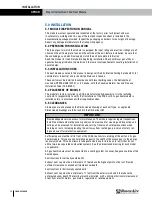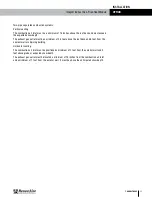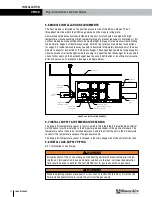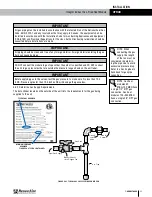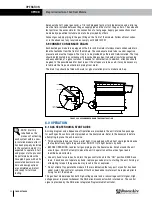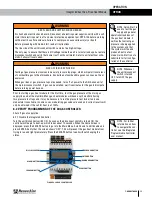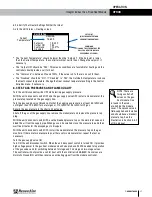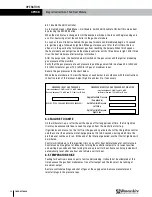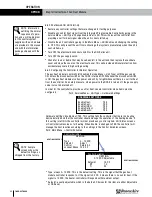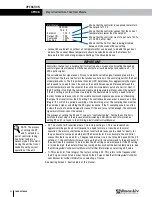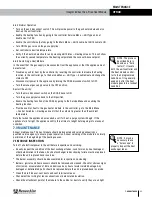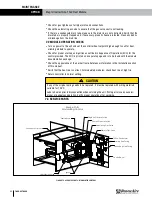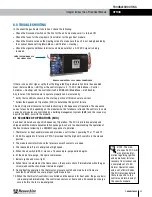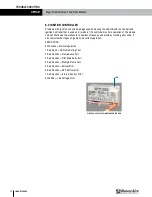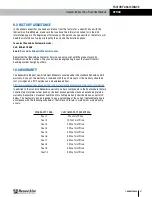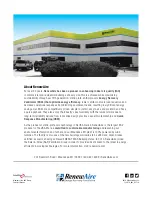
1.800.627.4499
42
Integral Indirect Gas-Fired Heat Module
OPTION
u
Lockout Above. Select an outdoor air temperature that can be used to disable the gas heat
module. The Lockout Above temperature should be selected based on the Outdoor Air
temperature that will no longer require heating of the Occupied Space.
u
KP. This stands for Proportional Gain. The factory setting is 1. This represents how
aggressively the gas heater will respond to a need for more (or less) heat. In normal
operation, the most cost-effective and most comfortable response to a need for heat is for
the gas heater to ramp up smoothly until the heat setpoint is met. Example: the controller
senses that there is a need for a 2 degree temperature rise in the Occupied Space. With a KP
setting of 1, the controller will slowly ramp up the Call for Heat command to the gas heater. If
the user finds this response to be too slow, the KP setting can be increased. If the KP setting
is raised too high, the heater will heat up rapidly and over-shoot the desired temperature. See
the
DN Integrated Controller User Manual
for further information on selecting a KP value.
u
Ti. This stands for Time Integral. The factory setting is 30. This refers to the frequency that
the KP signal is monitored in order to modify the KP signal. See the
DN Integrated Controller
User Manual
for further information on selecting a Ti value.
See Heating Screen 2, Section 6.6.3 of this manual.
NOTE: The process
of setting the KP
and Ti setpoints is
part of controller tuning.
Controller tuning is a
necessary part of commis-
sioning the unit but is not
needed to verify correct
operation of the unit.
Unit Status
Setpoint
72.0˚ F
70.5˚ F
Command
100%
HEATING
Output ON
YES
Disabled
YES
Shows that the Call for Heat is being disabled
because of the Lockout Above setting
Shows that the controller wants to put out a 100%,
or 10 VDC Call for Heat.
Shows that the controller senses that the current
temperature is lower than the setpoint.
Shows that the controller is supposed to maintain
the setpoint of 72˚ F.
IMPORTANT
Controllers that put out a variable Call for Heat require a means of anticipating the needed
control signal. Heat modules in DN-Series units are all variable output and require a 0 - 10
VDC control signal.
The variable control signal uses a PI loop to make the variable signal respond properly to a
Call for Heat. There are two factors that produce variations in the control signal that the heat
module responds to. The Proportional Constant (KP) determines how aggressively the signal
will respond to a need for heat. As soon as the controller senses a difference between the
current temperature and the setpoint, the controller immediately puts out a Call for Heat. If
the KP setting is too high, the command signal and temperature will over-shoot the setpoint.
If the KP setting is too low, it takes too long for the heat module to satisfy a need for heat.
In order to reduce the over-shoot, the variable command signal needs a means of damping
the signal that results from the KP setting. The controller also uses what is known as a Time
Integral (Ti), which is a periodic sampling of the remaining error. The sampling then modifies
the command signal, smoothing the KP signal response. If the Ti sampling occurs too often,
it slows the rate of command signal increase. If it doesn't occur often enough, the command
signal will still over-shoot the setpoint.
The process of setting the KP and Ti values is "controller tuning". Tuning the controller is
normally the last step in the process of commissioning a DN-Series unit. Information on
setting KP and Ti is found in the
DN Integrated Controller User Manual
.
OPERATION



